 Carency is a small village, a few miles NW of Arras and a little beyond
St.Eloi (near Vimy Ridge). It lies in the fertile plains of Artois along
the slopes of a narrow valley at the bottom of which is the Carency Stream
(which later becomes the River Souchez at Lens). It consists of five groups
of houses. One in the centre surrounding the church with the other four
facing the four cardinal points. To the north are the wood and small brook
of carency, and to the south steep ravines.
Carency is a small village, a few miles NW of Arras and a little beyond
St.Eloi (near Vimy Ridge). It lies in the fertile plains of Artois along
the slopes of a narrow valley at the bottom of which is the Carency Stream
(which later becomes the River Souchez at Lens). It consists of five groups
of houses. One in the centre surrounding the church with the other four
facing the four cardinal points. To the north are the wood and small brook
of carency, and to the south steep ravines.
The village had fallen into German hands in October 1914 and became a salient which protected Lens whilst denying the French direct communications between Arras and Béthune. Accordingly the Germans set about turning Carency into a miniature rock of Gibralter. Each street and every house was strengthened and fortified. Tunnels ran between each building. The flower gardens had been dug-up to provide weapons pits for machine-guns and close support artillery. All protected by four lines of trenches and wire held by four infantry battalions and six companies of pioneers under a brigadier-general.
Two French attacks in December 1914 were able to close to the northern and western outskirts of the village where violent machine-gun fire brought them to a halt. Throughout the winter and spring further operations were reduced to raids and mining. In this method the German outer defences were progressively destroyed and the French stranglehold on the position tightened. The Germans didn`t sit tight whilst all this was going on. They launched sudden and very bloody raids from their cellars and even mounted strong counter-attacks in an effort to dislodge the French.
During this period over 100 mine galleries were fired. Fierce combats raging around possession of the craters, which the French generally had the upper hand in. By May 1915, the ground to the west of the village had been so chaotically upheaved that further advances of any kind were impossible. So in an effort to break the stalemate General Petain`s 33rd Corps planned an attack that would clear the Germans from Carency, Ablain-Saint-Nazaire and Notre-Dame-deLorette. The ultimate aim would be Souchez which would put the French in an excellent position to re-take Vimy Ridge. The immediate task of taking Carency fell to General Fayolle`s 70th Division.
Artillery
At 6.00am on the clear, fine morning of May 9th the French artillery began pounding the German positions. The bombardment continued till 9.55am when it s uddenly doubled in intensity, then at 10.00am exactly, it stooped. From the French trenches whistles blew, and with the shouts of "En Avant" General Fayolle launched his attack on Carency from the south. In a single rush the French Poilu`s took a series of fortified ravines and carried three lines of trenches. Reaching the outskirts of the village they were brought to a halt by massed machine-gun fire. Working forward in small groups, the poilu`s were forced to take the village foot-by foot, brick by brick with bayonet and grenade. By the end of the evening, the southern group of buildings were in French hands and troops were separated from the Germans solely by the width of the Carency - Souchez road.
The assault continued on May 10th & 11th, the weight of the attack shifting to the east as the French attempted to envelope the village. The Souchez road was taken and the Bois de Carency taken in a glittering bayonet charge.
The following day, May 12th, the defended wooded hillock of Hill 125 and a fortified quarry to the north-west of the village fell to a two-pronged French attack with troops pressing both from the northwest and east. With this last bastion gone, the Germans in the village already cut-off for two days saw no hope left in continuing. First, one or two white hankies began to wave above the surviving parapets then more and more. The collapse of morale was infectious and soon over 1,000 men drawn from the Saxon Jaeger, Bavarian Chasseurs and Baden Guards were tumbling out of cellars and dug-outs with their hands up.
Though temporarily checked the offensive progressed more rapidly than the planners had anticipated. French troops made it to Givenchy but not for the first time in this war, reserves were unavailable, still being marshalled well to the rear; resulting in the loss of many of the initial gains including Givency. Still in thirteen days of fighting the French had taken Carency, Ablain-Saint-Nazaire and Notre-Dame-deLorette and had a toe-hold in Souchez which wouldn`t now fall until September 26th.
THE WARGAME
 The four day attack on Carency makes a very good mini-campaign, especially
if you are a solo gamer. Whilst the larger Artois offensive as a whole
would be a superb campaign for a die in the wool Great War wargamer.
The four day attack on Carency makes a very good mini-campaign, especially
if you are a solo gamer. Whilst the larger Artois offensive as a whole
would be a superb campaign for a die in the wool Great War wargamer.
We are looking solely at the first day of the battle only in this scenario, though there`s no reason why you shouldn`t play the whole four day assault as a mini-campaign, especially if you are a solo gamer; perhaps playing over successive evenings.
THE FRENCH
The French army was in transition in the early part of 1915. The ideals of the Furia Franchese had been crushed by the weight of German machine-gun fire in the autumn of 1914 but many still clung to romantic notions of warfare. 'Horizon bleu' had generally supplanted the typical red and blue of 1914, though many troops wore dark blue pantalons.
The 70th Division had two, possibly three infantry brigades. Each brigade organised as follows:
-
HQ
3 Reserve Infantry Regiments each:
HQ
37mm Infantry Gun Battery
3 Infantry Battalions each:
HQ
4 Infantry Companies of 4 platoons
1 Machine Gun Company of 3 platoons
In support the division`s own artillery comprised 3 groupes of 3 batteries of 75mm guns. Whilst Corps probably contributed 2 further groupes of 75mm and 2 batteries of 155mm Howitzers. All of these will be off-table. It`s likely that one infantry brigade of 6 battalions aided by a company of Pioneers attacked on the 9th. Corps held a groupé of Chasseurs à pied, so a battalion of these can be added to beef up the assault waves and add some colour.
I recommend using Irregular miniatures 6mm strips in accordance with the ELAN : DIVISIONAL COMBAT RULES FOR THE GREAT WAR by Matthew Hartley, which is now available direct from Gauntlet Pubs. Each strip of three figures represents 1 platoon. The seven battalions plus various odds and sods will come to around fifteen pounds!
THE GERMANS
I can only surmise the dispositions of the German forces. Of the six battalions holding Carency it`s likely that two were in the village itself. One or two holding Hill 125 and the quarry and a further two in the trenches to the south and east of the village.
So, for the scenario let`s have two battalions in the village (only one company of each are available for counter-attack). Two companies of Pioneers are also present. Another battalion is in the trenches to the south of the village and a fourth to the east.
- German Battalion HQ
4 Rifle Companies
each: 3 Infantry platoons
Supporting Troops
2 Companies of Pioneers each of 3 platoons
2 Machine-Gun Companies of 3 platoons
1 Battery of 105mm Howitzer
1 Battery of 77mm Guns
Off-Table Artillery Support 2 Batteries of 77mm Guns
2 Batteries of 105mm Howitzers
MORALE
German morale is 7 (simulates surprise and effects of bombardment) for the Infantry and 8 or 9 for the machine-gunners and Pioneers. Any troops held back for counter-attack have a morale of 9. Once the Souchez road is cut reduce by one).
French morale is 8 (reduce this by one per day to simulate thirst, hunger and exhaustion if playing the full campaign). The Chasseurs and Pioneers have a morale of 9.
FURTHER READING
My information came from ARRAS AND THE BATTLES OF ARTOIS from the Michelin Illustrated Guides To The Battlefields (1914-1918), published in 1920. This has recently been issued as a facsimile reprint by Turner Donovan Books. The action is also described in Terry Cave`s latest addition to the Battleground Europe series.
Back to The Gauntlet No. 13 Table of Contents
Back to The Gauntlet List of Issues
Back to Master Magazine List
© Copyright 1998 by Craig Martelle Publications
This article appears in MagWeb (Magazine Web) on the Internet World Wide Web.
Other military history articles and gaming articles are available at http://www.magweb.com